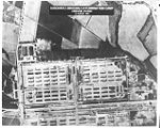
Extermination camps in the Holocaust
Encyclopedia
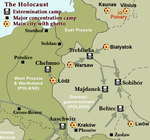
Nazi Germany
Nazi Germany , also known as the Third Reich , but officially called German Reich from 1933 to 1943 and Greater German Reich from 26 June 1943 onward, is the name commonly used to refer to the state of Germany from 1933 to 1945, when it was a totalitarian dictatorship ruled by...
during the Second World War
World War II
World War II, or the Second World War , was a global conflict lasting from 1939 to 1945, involving most of the world's nations—including all of the great powers—eventually forming two opposing military alliances: the Allies and the Axis...
(1939–45) to systematically kill millions by gassing and extreme work under starvation conditions. While there were victims from many groups, Jews
Jews
The Jews , also known as the Jewish people, are a nation and ethnoreligious group originating in the Israelites or Hebrews of the Ancient Near East. The Jewish ethnicity, nationality, and religion are strongly interrelated, as Judaism is the traditional faith of the Jewish nation...
were the main targets. This genocide
Genocide
Genocide is defined as "the deliberate and systematic destruction, in whole or in part, of an ethnic, racial, religious, or national group", though what constitutes enough of a "part" to qualify as genocide has been subject to much debate by legal scholars...
of the Jewish people was the Third Reich's "Final Solution
Final Solution
The Final Solution was Nazi Germany's plan and execution of the systematic genocide of European Jews during World War II, resulting in the most deadly phase of the Holocaust...
to the Jewish question
Jewish Question
The Jewish question encompasses the issues and resolutions surrounding the historically unequal civil, legal and national statuses between minority Ashkenazi Jews and non-Jews, particularly in Europe. The first issues discussed and debated by societies, politicians and writers in western and...
". The Nazi attempts at Jewish genocide are collectively known as the Holocaust
The Holocaust
The Holocaust , also known as the Shoah , was the genocide of approximately six million European Jews and millions of others during World War II, a programme of systematic state-sponsored murder by Nazi...
.
Background
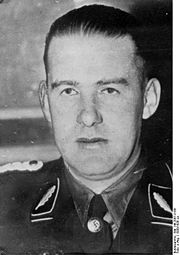

Heinrich Himmler
Heinrich Luitpold Himmler was Reichsführer of the SS, a military commander, and a leading member of the Nazi Party. As Chief of the German Police and the Minister of the Interior from 1943, Himmler oversaw all internal and external police and security forces, including the Gestapo...
ordered the Lublin District
Lublin
Lublin is the ninth largest city in Poland. It is the capital of Lublin Voivodeship with a population of 350,392 . Lublin is also the largest Polish city east of the Vistula river...
SS- und Polizeiführer
SS and Police Leader
SS and Police Leader was a title for senior Nazi officials that commanded large units of the SS, of Gestapo and of the regular German police during and prior to World War II.Three levels of subordination were established for bearers of this title:...
Odilo Globocnik
Odilo Globocnik
Odilo Lotario Globocnik was a prominent Austrian Nazi and later an SS leader. He was an acquaintance of Adolf Eichmann, who played a major role in the extermination of Jews and others during the Holocaust...
to build the first extermination camps during Aktion Reinhard (1941–43), the operation to annihilate every Jew in the General Government
General Government
The General Government was an area of Second Republic of Poland under Nazi German rule during World War II; designated as a separate region of the Third Reich between 1939–1945...
(occupied Poland). Initially, the victims' corpses were buried in mass grave
Mass grave
A mass grave is a grave containing multiple number of human corpses, which may or may not be identified prior to burial. There is no strict definition of the minimum number of bodies required to constitute a mass grave, although the United Nations defines a mass grave as a burial site which...
s, but later were cremated
Cremation
Cremation is the process of reducing bodies to basic chemical compounds such as gasses and bone fragments. This is accomplished through high-temperature burning, vaporization and oxidation....
. After Russian forces began to advance, previously buried victims were also exhumed and burned in Sonderaktion 1005
Sonderaktion 1005
The Sonderaktion 1005, also called Aktion 1005, or Enterdungsaktion was conducted during World War II to hide any evidence that millions of people had been murdered by Nazi Germany in Aktion Reinhard in occupied Poland....
, a Nazi attempt to destroy evidence of the Holocaust
The Holocaust
The Holocaust , also known as the Shoah , was the genocide of approximately six million European Jews and millions of others during World War II, a programme of systematic state-sponsored murder by Nazi...
.
The first concentration camps were under the direct command of SS–Polizei-führer Globocnik, and operated by SS Police battalions and Trawnikis
Trawniki concentration camp
Trawniki concentration camp, in the village of Trawniki about 40 km southeast of Lublin in Poland, was an SS labour camp which provided forced labourers for a nearby industrial plant to work in appalling conditions with little food...
—volunteers
Hiwi (volunteer)
Hiwi is a German abbreviation. It has two meanings, "voluntary assistant" and "assistant scientist" .- :...
from Eastern Europe; whereas the SS-Totenkopfverbände
SS-Totenkopfverbände
SS-Totenkopfverbände , meaning "Death's-Head Units", was the SS organization responsible for administering the Nazi concentration camps for the Third Reich....
managed the Nazi Concentration Camps
Nazi concentration camps
Nazi Germany maintained concentration camps throughout the territories it controlled. The first Nazi concentration camps set up in Germany were greatly expanded after the Reichstag fire of 1933, and were intended to hold political prisoners and opponents of the regime...
such as Dachau and Ravensbrück
Ravensbrück concentration camp
Ravensbrück was a notorious women's concentration camp during World War II, located in northern Germany, 90 km north of Berlin at a site near the village of Ravensbrück ....
. The Nazis did not expect the majority of prisoners taken to the Belzec
Belzec extermination camp
Belzec, Polish spelling Bełżec , was the first of the Nazi German extermination camps created for implementing Operation Reinhard during the Holocaust...
, Treblinka, and Sobibor
Sobibór extermination camp
Sobibor was a Nazi German extermination camp located on the outskirts of the town of Sobibór, Lublin Voivodeship of occupied Poland as part of Operation Reinhard; the official German name was SS-Sonderkommando Sobibor...
extermination camps to survive more than a few hours beyond arrival.
Definitions
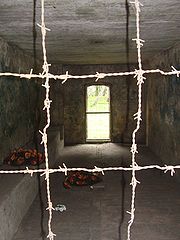
Genocide
Genocide is defined as "the deliberate and systematic destruction, in whole or in part, of an ethnic, racial, religious, or national group", though what constitutes enough of a "part" to qualify as genocide has been subject to much debate by legal scholars...
, not for punishing crime or containing political prisoners, but for the systematic killing of the prisoners delivered there.
Nazi Germany
Nazi Germany
Nazi Germany , also known as the Third Reich , but officially called German Reich from 1933 to 1943 and Greater German Reich from 26 June 1943 onward, is the name commonly used to refer to the state of Germany from 1933 to 1945, when it was a totalitarian dictatorship ruled by...
(1933–45) built the most infamous extermination camps in Occupied Poland. These differed from concentration camps, such as Dachau and Belsen
Bergen-Belsen concentration camp
Bergen-Belsen was a Nazi concentration camp in Lower Saxony in northwestern Germany, southwest of the town of Bergen near Celle...
, which were initially prison camps for people defined as socially or politically undesirable in Nazi society. In the early years of the Holocaust, the Jews were primarily sent to concentration camps
Nazi concentration camps
Nazi Germany maintained concentration camps throughout the territories it controlled. The first Nazi concentration camps set up in Germany were greatly expanded after the Reichstag fire of 1933, and were intended to hold political prisoners and opponents of the regime...
, but from 1942 onwards they were mostly deported
Deportation
Deportation means the expulsion of a person or group of people from a place or country. Today it often refers to the expulsion of foreign nationals whereas the expulsion of nationals is called banishment, exile, or penal transportation...
to the extermination camps.
Extermination camps are distinguished from the Arbeitslager
Arbeitslager
Arbeitslager is a German language word which means labor camp.The German government under Nazism used forced labor extensively, starting in the 1930s but most especially during World War II....
(forced labor camps) established in German-occupied countries to use the prisoners, including prisoners of war, as slave labor. In most camps (excepting PoW camps for the non-Soviet soldiers and certain labor camps), the high death rates resulted from execution, starvation
Starvation
Starvation is a severe deficiency in caloric energy, nutrient and vitamin intake. It is the most extreme form of malnutrition. In humans, prolonged starvation can cause permanent organ damage and eventually, death...
, disease
Disease
A disease is an abnormal condition affecting the body of an organism. It is often construed to be a medical condition associated with specific symptoms and signs. It may be caused by external factors, such as infectious disease, or it may be caused by internal dysfunctions, such as autoimmune...
, exhaustion, and physical brutality.
The Nazis
Nazism
Nazism, the common short form name of National Socialism was the ideology and practice of the Nazi Party and of Nazi Germany...
distinguished between extermination camps and concentration camps. As early as September 1942, Dr. Johann Paul Kremer, M.D., an SS
Schutzstaffel
The Schutzstaffel |Sig runes]]) was a major paramilitary organization under Adolf Hitler and the Nazi Party. Built upon the Nazi ideology, the SS under Heinrich Himmler's command was responsible for many of the crimes against humanity during World War II...
physician, witnessed a gassing of prisoners, and in his diary wrote: "They don't call Auschwitz the camp of annihilation [das Lager der Vernichtung] for nothing!" The distinction was evident during the Nuremberg trials
Nuremberg Trials
The Nuremberg Trials were a series of military tribunals, held by the victorious Allied forces of World War II, most notable for the prosecution of prominent members of the political, military, and economic leadership of the defeated Nazi Germany....
, when Dieter Wisliceny
Dieter Wisliceny
Dieter Wisliceny was a member of the Nazi SS, and a key executioner in the final phase of the Holocaust.Wisliceny studied theology without obtaining a degree...
(a deputy to Adolf Eichmann
Adolf Eichmann
Adolf Otto Eichmann was a German Nazi and SS-Obersturmbannführer and one of the major organizers of the Holocaust...
) was asked to name the extermination camps, and he identified Auschwitz
Auschwitz concentration camp
Concentration camp Auschwitz was a network of Nazi concentration and extermination camps built and operated by the Third Reich in Polish areas annexed by Nazi Germany during World War II...
and Majdanek
Majdanek
Majdanek was a German Nazi concentration camp on the outskirts of Lublin, Poland, established during the German Nazi occupation of Poland. The camp operated from October 1, 1941 until July 22, 1944, when it was captured nearly intact by the advancing Soviet Red Army...
as such. Then, when asked "How do you classify the camps Mauthausen
Mauthausen-Gusen concentration camp
Mauthausen Concentration Camp grew to become a large group of Nazi concentration camps that was built around the villages of Mauthausen and Gusen in Upper Austria, roughly east of the city of Linz.Initially a single camp at Mauthausen, it expanded over time and by the summer of 1940, the...
, Dachau, and Buchenwald
Buchenwald concentration camp
Buchenwald concentration camp was a German Nazi concentration camp established on the Ettersberg near Weimar, Germany, in July 1937, one of the first and the largest of the concentration camps on German soil.Camp prisoners from all over Europe and Russia—Jews, non-Jewish Poles and Slovenes,...
?" he replied, "They were normal concentration camps, from the point of view of the department of Eichmann."
The camps
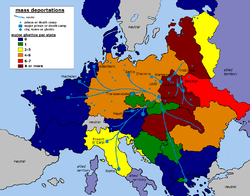
Polish areas annexed by Nazi Germany
At the beginning of World War II, nearly a quarter of the pre-war Polish areas were annexed by Nazi Germany and placed directly under German civil administration, while the rest of Nazi occupied Poland was named as General Government...
(October 1939), four in the General Government
General Government
The General Government was an area of Second Republic of Poland under Nazi German rule during World War II; designated as a separate region of the Third Reich between 1939–1945...
area.
- Auschwitz II (Auschwitz-Birkenau)Auschwitz concentration campConcentration camp Auschwitz was a network of Nazi concentration and extermination camps built and operated by the Third Reich in Polish areas annexed by Nazi Germany during World War II...
- Chełmno
- BelzecBelzec extermination campBelzec, Polish spelling Bełżec , was the first of the Nazi German extermination camps created for implementing Operation Reinhard during the Holocaust...
- MajdanekMajdanekMajdanek was a German Nazi concentration camp on the outskirts of Lublin, Poland, established during the German Nazi occupation of Poland. The camp operated from October 1, 1941 until July 22, 1944, when it was captured nearly intact by the advancing Soviet Red Army...
- SobiborSobibór extermination campSobibor was a Nazi German extermination camp located on the outskirts of the town of Sobibór, Lublin Voivodeship of occupied Poland as part of Operation Reinhard; the official German name was SS-Sonderkommando Sobibor...
- TreblinkaTreblinka extermination campTreblinka was a Nazi extermination camp in occupied Poland during World War II near the village of Treblinka in the modern-day Masovian Voivodeship of Poland. The camp, which was constructed as part of Operation Reinhard, operated between and ,. During this time, approximately 850,000 men, women...
Besides those six camps, there existed the little-known Maly Trostenets extermination camp
Maly Trostenets extermination camp
Maly Trastsianiets extermination camp , located near a small village on the outskirts of Minsk, Belarus, was the site of a Nazi extermination camp.- History :...
, at Minsk
Minsk
- Ecological situation :The ecological situation is monitored by Republican Center of Radioactive and Environmental Control .During 2003–2008 the overall weight of contaminants increased from 186,000 to 247,400 tons. The change of gas as industrial fuel to mazut for financial reasons has worsened...
, Belarus
Belarus
Belarus , officially the Republic of Belarus, is a landlocked country in Eastern Europe, bordered clockwise by Russia to the northeast, Ukraine to the south, Poland to the west, and Lithuania and Latvia to the northwest. Its capital is Minsk; other major cities include Brest, Grodno , Gomel ,...
, in the anti-Communist
Anti-communism
Anti-communism is opposition to communism. Organized anti-communism developed in reaction to the rise of communism, especially after the 1917 October Revolution in Russia and the beginning of the Cold War in 1947.-Objections to communist theory:...
Lokot Republic
Lokot Republic
The Lokot Autonomy was a semi-autonomous region in Nazi German-occupied Central Russia led by Bronislav Kaminski's administration from July 1942 to August 1943. The name is derived from the region's administrative center, the urban-type settlement of Lokot in Oryol Oblast...
(July 1942–August 1943) established in the Nazi-occupied USSR; similar camps existed at Warsaw and Janowska. Moreover, in Yugoslavia
Yugoslavia
Yugoslavia refers to three political entities that existed successively on the western part of the Balkans during most of the 20th century....
there existed the Jasenovac concentration camp
Jasenovac concentration camp
Jasenovac concentration camp was the largest extermination camp in the Independent State of Croatia and occupied Yugoslavia during World War II...
(August 1941–April 1945), which was the only central extermination camp outside of Poland, and the only one not operated by Nazis, but by the fascist
Fascism
Fascism is a radical authoritarian nationalist political ideology. Fascists seek to rejuvenate their nation based on commitment to the national community as an organic entity, in which individuals are bound together in national identity by suprapersonal connections of ancestry, culture, and blood...
Ustaše
Ustaše
The Ustaša - Croatian Revolutionary Movement was a Croatian fascist anti-Yugoslav separatist movement. The ideology of the movement was a blend of fascism, Nazism, and Croatian nationalism. The Ustaše supported the creation of a Greater Croatia that would span to the River Drina and to the border...
forces of the Independent State of Croatia
Independent State of Croatia
The Independent State of Croatia was a World War II puppet state of Nazi Germany, established on a part of Axis-occupied Yugoslavia. The NDH was founded on 10 April 1941, after the invasion of Yugoslavia by the Axis powers. All of Bosnia and Herzegovina was annexed to NDH, together with some parts...
, the majority of whose victims were Orthodox Christian Serbs, Roma, and Jews.
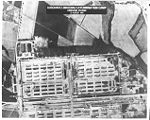
The Nazis used the euphemism
Euphemism
A euphemism is the substitution of a mild, inoffensive, relatively uncontroversial phrase for another more frank expression that might offend or otherwise suggest something unpleasant to the audience...
Endlösung der Judenfrage (Final Solution of the Jewish Question
Final Solution
The Final Solution was Nazi Germany's plan and execution of the systematic genocide of European Jews during World War II, resulting in the most deadly phase of the Holocaust...
) to describe their systematic killing of Europe's Jews, which Nazi leaders likely decided during the first half of 1941. The initial, formal killings of the Final Solution were undertaken by the SS Einsatzgruppen
Einsatzgruppen
Einsatzgruppen were SS paramilitary death squads that were responsible for mass killings, typically by shooting, of Jews in particular, but also significant numbers of other population groups and political categories...
(Task Forces) death squads who followed the Wehrmacht
Wehrmacht
The Wehrmacht – from , to defend and , the might/power) were the unified armed forces of Nazi Germany from 1935 to 1945. It consisted of the Heer , the Kriegsmarine and the Luftwaffe .-Origin and use of the term:...
during the Operation Barbarossa
Operation Barbarossa
Operation Barbarossa was the code name for Germany's invasion of the Soviet Union during World War II that began on 22 June 1941. Over 4.5 million troops of the Axis powers invaded the USSR along a front., the largest invasion in the history of warfare...
invasion of the USSR in June 1941. The initial extermination method of shooting people in burial pits proved logistically and psychologically inefficient, so in late 1941, the Nazis established camps specifically for mass extermination via gas chambers. The logistical details were established in the Wannsee Conference
Wannsee Conference
The Wannsee Conference was a meeting of senior officials of the Nazi German regime, held in the Berlin suburb of Wannsee on 20 January 1942. The purpose of the conference was to inform administrative leaders of Departments responsible for various policies relating to Jews, that Reinhard Heydrich...
(January 1942) and were executed by the administrator Adolf Eichmann
Adolf Eichmann
Adolf Otto Eichmann was a German Nazi and SS-Obersturmbannführer and one of the major organizers of the Holocaust...
. The camps at Treblinka, Bełżec
Belzec extermination camp
Belzec, Polish spelling Bełżec , was the first of the Nazi German extermination camps created for implementing Operation Reinhard during the Holocaust...
, and Sobibor
Sobibór extermination camp
Sobibor was a Nazi German extermination camp located on the outskirts of the town of Sobibór, Lublin Voivodeship of occupied Poland as part of Operation Reinhard; the official German name was SS-Sonderkommando Sobibor...
, were constructed during Operation Reinhard
Operation Reinhard
Operation Reinhard was the code name given to the Nazi plan to murder Polish Jews in the General Government, and marked the most deadly phase of the Holocaust, the use of extermination camps...
(October 1941–November 1943), for the extermination of Poland's Jews.
Whereas the Auschwitz II (Auschwitz–Birkenau) and Majdanek camps were parts of a labor camp
Labor camp
A labor camp is a simplified detention facility where inmates are forced to engage in penal labor. Labor camps have many common aspects with slavery and with prisons...
complex, the Operation Reinhard camps and the Chełmno
Chelmno extermination camp
Chełmno extermination camp, also known as the Kulmhof concentration camp, was a Nazi German extermination camp that was situated 50 kilometres from Łódź, near a small village called Chełmno nad Nerem . After annexation by Germany Kulmhof was included into Reichsgau Wartheland in 1939...
camp were exclusively for the quick extermination of many people (primarily Jews) within hours of their arrival. Some able-bodied prisoners delivered to the death camp were not immediately killed, but were forced into labor units (Sonderkommando
Sonderkommando
Sonderkommandos were work units of Nazi death camp prisoners, composed almost entirely of Jews, who were forced, on threat of their own deaths, to aid with the disposal of gas chamber victims during The Holocaust...
) to work at the extermination process, removing corpses from the gas chambers
Gas Chambers
Gas Chambers is a fast, hollow and shallow point break type of wave. Being that it is a high performance wave it is well suited for the average to pro level surfer. Gas Chambers is located on the North Shore of Oahu about a 1/4 of a mile north of Ehukai Beach Park and 1/2 a mile west of Sunset...
and burning them. Because the extermination camps were physically small (only several hundred metres long and wide) and equipped with minimal housing and support installations, the Nazis deceived
Psychological warfare
Psychological warfare , or the basic aspects of modern psychological operations , have been known by many other names or terms, including Psy Ops, Political Warfare, “Hearts and Minds,” and Propaganda...
the prisoners upon their arrival, telling them that they were at a temporary transit stop, and soon would continue to an Arbeitslager
Arbeitslager
Arbeitslager is a German language word which means labor camp.The German government under Nazism used forced labor extensively, starting in the 1930s but most especially during World War II....
(work camp) farther east.
Numbers of victims
The estimated total number of people killed in these camps is 2,814,500:| Camp | Estimated deaths | Notes/references |
|---|---|---|
| Auschwitz–Birkenau | 1,100,000 | |
| Treblinka | 700,000–800,000 | The Höfle Telegram Höfle Telegram The Höfle Telegram is a document discovered in 2000 among recently declassified World War II materials from the Public Record Office in Kew, England... indicates some 700,000 killed by 31 December 1942, yet the camp functioned until 1943, hence the true deaths total likely is greater. |
| Bełżec | 434,500 | |
| Sobibor | 167,000–250,000 | |
| Chełmno | 152,000 | |
| Majdanek | 78,000 | |
| Total | 2,631,500–2,814,500 | |
The approximate total numbers of people killed in the lesser-known death camps, vary between 85,000 to 600,000 at the Jasenovac concentration camp
Jasenovac concentration camp
Jasenovac concentration camp was the largest extermination camp in the Independent State of Croatia and occupied Yugoslavia during World War II...
in Yugoslavia. At the Maly Trostenets extermination camp
Maly Trostenets extermination camp
Maly Trastsianiets extermination camp , located near a small village on the outskirts of Minsk, Belarus, was the site of a Nazi extermination camp.- History :...
in Belarus, USSR, some 65,000 Jews were killed, whilst the number of gentiles
Gentile
The term Gentile refers to non-Israelite peoples or nations in English translations of the Bible....
(non-Jews, i.e. communists, priests, non-religious, soldiers, et al.) varies between 100,000 to 400,000.
Selection of sites for the camps
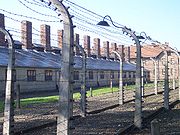
Nazi Germany
Nazi Germany , also known as the Third Reich , but officially called German Reich from 1933 to 1943 and Greater German Reich from 26 June 1943 onward, is the name commonly used to refer to the state of Germany from 1933 to 1945, when it was a totalitarian dictatorship ruled by...
built most extermination camps in occupied Poland
Second Polish Republic
The Second Polish Republic, Second Commonwealth of Poland or interwar Poland refers to Poland between the two world wars; a period in Polish history in which Poland was restored as an independent state. Officially known as the Republic of Poland or the Commonwealth of Poland , the Polish state was...
:
- Camps were built where most of the intended victims lived; Poland had the greatest European Jewish populace.
- The camps could be kept secret from the German civil populace.
Operation of the camps
The formal mass-killing method at an extermination camp was poison gas (made to order by the IG FarbenIG Farben
I.G. Farbenindustrie AG was a German chemical industry conglomerate. Its name is taken from Interessen-Gemeinschaft Farbenindustrie AG . The company was formed in 1925 from a number of major companies that had been working together closely since World War I...
chemicals company); besides gas chamber
Gas chamber
A gas chamber is an apparatus for killing humans or animals with gas, consisting of a sealed chamber into which a poisonous or asphyxiant gas is introduced. The most commonly used poisonous agent is hydrogen cyanide; carbon dioxide and carbon monoxide have also been used...
s, the camp guards continued killing prisoners via mass shooting, starvation, torture, et cetera. After the war, the diary of the Auschwitz Commandant, Rudolf Höss, revealed that psychologically "unable to endure wading through blood any longer", many Einsatzkommando
Einsatzkommando
During World War II, the Nazi German Einsatzkommandos were a sub-group of five Einsatzgruppen mobile killing squads—up to 3,000 men each—usually composed of 500-1,000 functionaries of the SS and Gestapo, whose mission was to kill Jews, Romani, communists and the NKVD collaborators in the captured...
s—the killers — either went mad or killed themselves
Suicide
Suicide is the act of intentionally causing one's own death. Suicide is often committed out of despair or attributed to some underlying mental disorder, such as depression, bipolar disorder, schizophrenia, alcoholism, or drug abuse...
.
Operationally, there were three types of death camp:
(1) Aktion Reinhardt extermination camps: Treblinka, Sobibor, Belzec, where prisoners were promptly killed upon arrival. Initially, the camps used carbon monoxide gas chambers; at first, the corpses were buried, but then incinerated atop pyres. Later, gas chambers and crematoria were built in Treblinka and Belzec; Zyklon-B was used in Belzec.
(2) Concentration–extermination camps where some prisoners were selected for slave labor, instead of immediate death; they were kept alive as camp inmates, available to work wherever the Nazis required. These camps — including Auschwitz, Majdanek, and Jasenovac — later were retrofitted with Zyklon-B gas chambers and crematoria, remaining operational until war's end in 1945.
(3) Minor extermination camps such as Sajmiste
Sajmište concentration camp
Sajmište concentration camp was a German run Nazi concentration camp located on the outskirts of Belgrade whilst part of NDH . It was established in December 1941 and shut down in September 1944...
in Serbia, Maly Trostenets
Maly Trostenets extermination camp
Maly Trastsianiets extermination camp , located near a small village on the outskirts of Minsk, Belarus, was the site of a Nazi extermination camp.- History :...
in the USSR, Janowska, in Poland, and Gornija Rijeka, initially operated as prisons and transit camps, then as extermination camps late in the war, using portable gas-chambers and gas van
Gas van
The gas van or gas wagon was an extermination method devised by Nazi Germany to kill victims of the regime. It was also rumored that analog of such device was used by the Soviet Union on an experimental basis during the Great Purge-Nazi Germany:...
s. Gas vans were initially developed at the Chelmno extermination camp
Chelmno extermination camp
Chełmno extermination camp, also known as the Kulmhof concentration camp, was a Nazi German extermination camp that was situated 50 kilometres from Łódź, near a small village called Chełmno nad Nerem . After annexation by Germany Kulmhof was included into Reichsgau Wartheland in 1939...
, before being used elsewhere.
The corpses were incinerated in crematoria and the ashes either buried or scattered; yet, at Sobibor
Sobibór extermination camp
Sobibor was a Nazi German extermination camp located on the outskirts of the town of Sobibór, Lublin Voivodeship of occupied Poland as part of Operation Reinhard; the official German name was SS-Sonderkommando Sobibor...
, Treblinka, Belzec, and Chelmno, the corpses were incinerated on pyre
Pyre
A pyre , also known as a funeral pyre, is a structure, usually made of wood, for burning a body as part of a funeral rite...
s. The efficiency of industrialised killing at Auschwitz-Birkenau produced too many corpses to adequately burn or bury, so the crematoria (manufactured to specification by Topf und Söhne
Topf and Sons
J.A. Topf and Sons was a German engineering company, which designed and built the incineration furnaces used by the Nazis at concentration and extermination camps during the Holocaust; including Auschwitz-Birkenau, Buchenwald, Belzec, Dachau, Mauthausen and Gusen...
) were put into use to handle the disposals around the clock, day and night.
Systematic killing
Each extermination camp operated differently, yet each was designed for quick and efficient industrialized killing. SS ObersturmführerObersturmführer
Obersturmführer was a paramilitary rank of the Nazi party that was used by the SS and also as a rank of the SA. Translated as “Senior Assault Leader”, the rank of Obersturmführer was first created in 1932 as the result of an expansion of the Sturmabteilung and the need for an additional rank in...
Kurt Gerstein
Kurt Gerstein
Kurt Gerstein was a German SS officer and member of the Institute for Hygiene of the Waffen-SS. He witnessed mass murders in the Nazi extermination camps Belzec and Treblinka...
, of the Institute for Hygiene of the Waffen-SS
Waffen-SS
The Waffen-SS was a multi-ethnic and multi-national military force of the Third Reich. It constituted the armed wing of the Schutzstaffel or SS, an organ of the Nazi Party. The Waffen-SS saw action throughout World War II and grew from three regiments to over 38 divisions, and served alongside...
, during the war told a Swedish diplomat of life in a death camp, of how, on 19 August 1942, he arrived at Belzec extermination camp
Belzec extermination camp
Belzec, Polish spelling Bełżec , was the first of the Nazi German extermination camps created for implementing Operation Reinhard during the Holocaust...
(which was equipped with carbon monoxide gas chambers) and was shown the unloading of 45 train cars filled with 6,700 Jews, many already dead, but the rest were marched naked to the gas chambers, where:
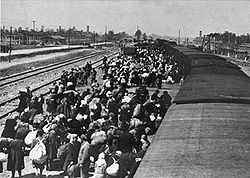
Unterscharführer Hackenholt was making great efforts to get the engine running. But it doesn't go. Captain WirthChristian WirthChristian Wirth was a German police and SS officer who was one of the leading contributors to the program to exterminate the Jewish people of Poland, known as Operation Reinhard....
comes up. I can see he is afraid, because I am present at a disaster. Yes, I see it all and I wait. My stopwatch showed it all, 50 minutes, 70 minutes, and the diesel [engine] did not start. The people wait inside the gas chambers. In vain. They can be heard weeping, "like in the synagogue", says Professor Pfannenstiel, his eyes glued to a window in the wooden door. Furious, Captain Wirth lashes the Ukrainian [prisoner] assisting Hackenholt twelve, thirteen times, in the face. After 2 hours and 49 minutes — the stopwatch recorded it all — the diesel started. Up to that moment, the people shut up in those four crowded chambers were still alive, four times 750 persons, in four times 45 cubic meters. Another 25 minutes elapsed. Many were already dead, that could be seen through the small window, because an electric lamp inside lit up the chamber for a few moments. After 28 minutes, only a few were still alive. Finally, after 32 minutes, all were dead . . . Dentists [then] hammered out gold teeth, bridges, and crowns. In the midst of them stood Captain Wirth. He was in his element, and, showing me a large can full of teeth, he said: "See, for yourself, the weight of that gold! It's only from yesterday, and the day before. You can't imagine what we find every day — dollars, diamonds, gold. You'll see for yourself!"
Auschwitz Camp Commandant Rudolf Höss reported that the first time Zyklon B
Zyklon B
Zyklon B was the trade name of a cyanide-based pesticide infamous for its use by Nazi Germany to kill human beings in gas chambers of extermination camps during the Holocaust. The "B" designation indicates one of two types of Zyklon...
gas was used on the Jews, many suspected they were to be killed — despite having been deceived
Psychological warfare
Psychological warfare , or the basic aspects of modern psychological operations , have been known by many other names or terms, including Psy Ops, Political Warfare, “Hearts and Minds,” and Propaganda...
into believing they were to be deloused and then interned to the camp. As a result, the Nazis identified and isolated "difficult individuals" who might alert the prisoners, and removed them from the mass —lest they incite revolt among the deceived majority of prisoners en route to the gas chambers. The "difficult" prisoners were led to a site out of view to be killed off discreetly.
A prisoner Sonderkommando
Sonderkommando
Sonderkommandos were work units of Nazi death camp prisoners, composed almost entirely of Jews, who were forced, on threat of their own deaths, to aid with the disposal of gas chamber victims during The Holocaust...
(Special Detachment) effected the most of the processes of extermination; they accompanied the Jews into the gas chamber, and remained with them until the chamber door closed. To psychologically maintain the "calming effect" of the delousing deception, an SS guard stood at the door, as if awaiting the prisoners. The Sonderkommando hurried them to undress and enter the "shower room" (gas chamber) as quickly as possible; to that effect, they also assisted the aged and the very young in undressing.
To further persuade the prisoners that nothing harmful was happening, the Sonderkommando deceived them with small talk about camp life. Fearing that the delousing "disinfectant" might harm their children, many mothers hid their infants beneath their piled clothes. Camp Commandant Höss reported that the "men of the Special Detachment were particularly on the look-out for this", and encouraged the women to take their children into the "shower room". Likewise, the Sonderkommando comforted older children who might cry "because of the strangeness of being undressed in this fashion".
Yet, not every prisoner was deceived by such psychological warfare
Psychological warfare
Psychological warfare , or the basic aspects of modern psychological operations , have been known by many other names or terms, including Psy Ops, Political Warfare, “Hearts and Minds,” and Propaganda...
tactics; Commandant Höss reported of Jews "who either guessed, or knew, what awaited them, nevertheless . . . [they] found the courage to joke with the children, to encourage them, despite the mortal terror visible in their own eyes". Some women would suddenly "give the most terrible shrieks while undressing, or tear their hair, or scream like maniacs"; the Sonderkommando immediately took them away for immediate execution by shooting. In such circumstances, others, meaning to save themselves at the gas chamber's threshold, betrayed the identities and "revealed the addresses of those members of their race still in hiding".
Once the door of the filled gas chamber was sealed, pellets of Zyklon B
Zyklon B
Zyklon B was the trade name of a cyanide-based pesticide infamous for its use by Nazi Germany to kill human beings in gas chambers of extermination camps during the Holocaust. The "B" designation indicates one of two types of Zyklon...
were dropped through special holes in the roof. Nazi regulations required that the Camp Commandant supervise the preparations, the gassing (through a peephole), and the aftermath looting of the corpses. Commandant Höss reported that the gassed victims "showed no signs of convulsion"; the Auschwitz camp physicians attributed that to the "paralyzing effect on the lungs" of the Zyklon-B gas, which killed before the victim began suffering convulsions.
After the gassings, the Sonderkommando removed the corpses from the gas chamber
Gas chamber
A gas chamber is an apparatus for killing humans or animals with gas, consisting of a sealed chamber into which a poisonous or asphyxiant gas is introduced. The most commonly used poisonous agent is hydrogen cyanide; carbon dioxide and carbon monoxide have also been used...
, then extracted any gold teeth, and — to minimize the distinct smell of burning human hair — they shaved the corpses, before delivering them to the crematoria or to the fire pits, thus maintaining secret the existence of the extermination camp. The Sonderkommando were responsible for burning the corpses, and stoking the fires, draining body fat, and turning over the "mountain of burning corpses" for even combustion and a peak fire-temperature. Commandant Höss was impressed by the diligence of the Sonderkommando prisoners, despite their being "well aware that . . . they, too, would meet exactly the same fate", yet always doing their jobs "in such a matter-of-course manner that they might, themselves, have been the exterminators". Höss further reported that the men ate and smoked "even when engaged in the grisly job of burning corpses", in the course of which they occasionally encountered the corpse of a relative, but, although they "were obviously affected by this . . . it never led to any incident" of revolt, as in the case of a Sonderkommando who so encountered the corpse of his wife, yet behaved "as though nothing had happened".
As a matter of political training, some high-rank Nazi Party leaders and SS officers were sent to Auschwitz–Birkenau
Auschwitz concentration camp
Concentration camp Auschwitz was a network of Nazi concentration and extermination camps built and operated by the Third Reich in Polish areas annexed by Nazi Germany during World War II...
to witness the gassings; Höss reported that "all were deeply impressed by what they saw . . . [yet some] . . . who had previously spoken most loudly, about the necessity for this extermination, fell silent once they had actually seen the 'final solution of the Jewish problem'." As the Auschwitz Camp Commandant Rudolf Höss justified the extermination by explaining the need for "the iron determination with which we must carry out Hitler's orders"; yet saw that even "[Adolf] Eichmann, who certainly [was] tough enough, had no wish to change places with me."
The post-war period
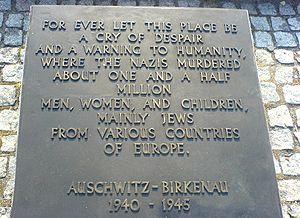
Red Army
The Workers' and Peasants' Red Army started out as the Soviet Union's revolutionary communist combat groups during the Russian Civil War of 1918-1922. It grew into the national army of the Soviet Union. By the 1930s the Red Army was among the largest armies in history.The "Red Army" name refers to...
advanced into eastern Poland, the Nazis either partly or completely dismantled the eastern-most extermination camps to conceal the mass killings done there, and the buried remains (excepting Auschwitz–Birkenau
Auschwitz concentration camp
Concentration camp Auschwitz was a network of Nazi concentration and extermination camps built and operated by the Third Reich in Polish areas annexed by Nazi Germany during World War II...
, which was partially demolished in 1947). Because most of the death camps in the far east of the country (Belzec
Belzec
Bełżec is a village in Tomaszów Lubelski County, Lublin Voivodeship, in eastern Poland. It is the seat of the gmina called Gmina Bełżec. It lies approximately south of Tomaszów Lubelski and south-east of the regional capital Lublin.During World War II it was the site of the Nazi Bełżec...
and Sobibor
Sobibór
Sobibór is a village in the administrative district of Gmina Włodawa, within Włodawa County, Lublin Voivodeship, in eastern Poland. It lies close to the Bug River, which forms the border with Belarus and Ukraine. Sobibór is approximately south-east of Włodawa and east of the regional capital...
) had been constructed with local lumber, the physical installations were quickly deteriorated, eroded, and destroyed, by the natural elements.

People's Republic of Poland
The People's Republic of Poland was the official name of Poland from 1952 to 1990. Although the Soviet Union took control of the country immediately after the liberation from Nazi Germany in 1944, the name of the state was not changed until eight years later...
(1944–90) created monument
Monument
A monument is a type of structure either explicitly created to commemorate a person or important event or which has become important to a social group as a part of their remembrance of historic times or cultural heritage, or simply as an example of historic architecture...
s at the extermination camp sites, that mentioned no ethnic, religious, or national particulars of the Nazi victims. In 1989, upon the collapse of Polish communism, the extermination camps sites became accessible to Western visitors to Poland; the camps are tourist attractions
Tourism
Tourism is travel for recreational, leisure or business purposes. The World Tourism Organization defines tourists as people "traveling to and staying in places outside their usual environment for not more than one consecutive year for leisure, business and other purposes".Tourism has become a...
, especially the most-infamous Nazi death camp, Auschwitz concentration camp
Auschwitz concentration camp
Concentration camp Auschwitz was a network of Nazi concentration and extermination camps built and operated by the Third Reich in Polish areas annexed by Nazi Germany during World War II...
, near the town of Oświęcim
Oswiecim
Oświęcim is a town in the Lesser Poland province of southern Poland, situated west of Kraków, near the confluence of the rivers Vistula and Soła.- History :...
(Auschwitz). In the early 1990s, Jewish Holocaust organisations disputed with Polish Catholic groups about: "What religious symbols of martyrdom are appropriate as memorials in a Nazi death camp such as Auschwitz?" The Jews opposed to the erection of Christian
Christian
A Christian is a person who adheres to Christianity, an Abrahamic, monotheistic religion based on the life and teachings of Jesus of Nazareth as recorded in the Canonical gospels and the letters of the New Testament...
memorial
Memorial
A memorial is an object which serves as a focus for memory of something, usually a person or an event. Popular forms of memorials include landmark objects or art objects such as sculptures, statues or fountains, and even entire parks....
s at a quarry adjacent to the Auschwitz camp, wherein featured the Auschwitz cross
Auschwitz cross
The Auschwitz cross is a cross erected near the Auschwitz concentration camp. In 1979, the newly elected Polish Pope John Paul II said mass on the grounds of the Auschwitz II extermination camp to some 500,000 people. An 8.6 metre tall cross was erected there for the purpose, and removed after...
— a Roman cross erected near death camp Auschwitz I, where mostly Poles were killed, rather than at Auschwitz II (Auschwitz-Birkenau), where mostly Jews were killed.
Holocaust denial
Holocaust deniersHolocaust denial
Holocaust denial is the act of denying the genocide of Jews in World War II, usually referred to as the Holocaust. The key claims of Holocaust denial are: the German Nazi government had no official policy or intention of exterminating Jews, Nazi authorities did not use extermination camps and gas...
are people and organisations who assert that the Holocaust did not occur, or that it did not occur in the historically recognized manner and extent.

Robert Faurisson
Robert Faurisson is a French academic who is a Holocaust denier. Faurisson generated much controversy with a number of articles, published in the Journal of Historical Review and elsewhere, as well as various letters he has sent to French newspapers , which deny various aspects of the Holocaust,...
in his publications said that "Hitler's 'gas chambers' never existed" — that the existence of gas chambers in the extermination camps was "essentially of Zionist
Zionism
Zionism is a Jewish political movement that, in its broadest sense, has supported the self-determination of the Jewish people in a sovereign Jewish national homeland. Since the establishment of the State of Israel, the Zionist movement continues primarily to advocate on behalf of the Jewish state...
origin"; that The Diary of Anne Frank is inauthentic; that Elie Wiesel
Elie Wiesel
Sir Eliezer "Elie" Wiesel KBE; born September 30, 1928) is a Hungarian-born Jewish-American writer, professor, political activist, Nobel Laureate, and Holocaust survivor. He is the author of 57 books, including Night, a work based on his experiences as a prisoner in the Auschwitz, Buna, and...
lied about what he lived in under the Nazis
Nazism
Nazism, the common short form name of National Socialism was the ideology and practice of the Nazi Party and of Nazi Germany...
; and that no more than 6 million people were killed in the camps.
In 2005, in Austria, where Holocaust denial is a crime, the Austrians, acting upon a 1989 arrest warrant, detained British author David Irving
David Irving
David John Cawdell Irving is an English writer,best known for his denial of the Holocaust, who specialises in the military and political history of World War II, with a focus on Nazi Germany...
for the crime of "trivialising the Holocaust"; his trial
Irving trial
In 2005, the British Holocaust denier David Irving was arrested for Holocaust denial in Austria. In early 2006, he was convicted and served a thirteen-month prison sentence.-Actions:...
earned him thirteen months imprisonment in 2006, and subsequent perpetual banishment from Austria
Austria
Austria , officially the Republic of Austria , is a landlocked country of roughly 8.4 million people in Central Europe. It is bordered by the Czech Republic and Germany to the north, Slovakia and Hungary to the east, Slovenia and Italy to the south, and Switzerland and Liechtenstein to the...
.
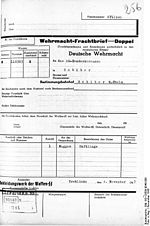
Final Solution
The Final Solution was Nazi Germany's plan and execution of the systematic genocide of European Jews during World War II, resulting in the most deadly phase of the Holocaust...
perpetrators, material evidence (the remaining camps, etc.), Nazi photographs and films of the killings, and camp administration records. Educational efforts, such as those of the Nizkor Project
Nizkor Project
The Nizkor Project is an ongoing Internet-based project run by B'nai Brith Canada which is dedicated to countering Holocaust denial. It was founded by Ken McVay as a central Web-based archive for the large numbers of documents made publicly available by the users of the newsgroup alt.revisionism...
and the Simon Wiesenthal Center
Simon Wiesenthal Center
The Simon Wiesenthal Center , with headquarters in Los Angeles, California, was established in 1977 and named for Simon Wiesenthal, the Nazi hunter. According to its mission statement, it is "an international Jewish human rights organization dedicated to repairing the world one step at a time...
, and the books of Deborah Lipstadt
Deborah Lipstadt
Deborah Esther Lipstadt, Ph.D. is an American historian and author of the book Denying the Holocaust and The Eichmann Trial. She is the Dorot Professor of Modern Jewish and Holocaust Studies at Emory University...
and Simon Wiesenthal
Simon Wiesenthal
Simon Wiesenthal KBE was an Austrian Holocaust survivor who became famous after World War II for his work as a Nazi hunter....
, and those at Holocaust resources, all track and explain Holocaust denial. The books of (Holocaust) historians, such as Raul Hilberg
Raul Hilberg
Raul Hilberg was an Austrian-born American political scientist and historian. He was widely considered to be the world's preeminent scholar of the Holocaust, and his three-volume, 1,273-page magnum opus, The Destruction of the European Jews, is regarded as a seminal study of the Nazi Final...
(The Destruction of the European Jews
The Destruction of the European Jews
The Destruction of the European Jews is a book published in 1961 by historian Raul Hilberg. Hilberg revised his work in 1985, and it appeared in a new three-volume edition. It is largely held to be the first comprehensive historical study of the Holocaust. According to Holocaust historian, Michael R...
, 1961, 1985), Lucy Davidowicz (The War Against the Jews
The War Against the Jews
The War Against the Jews is a 1975 book authored by Lucy Dawidowicz. The book researches the Holocaust of the European Jewry during World War II....
, 1975), Ian Kershaw
Ian Kershaw
Sir Ian Kershaw is a British historian of 20th-century Germany whose work has chiefly focused on the period of the Third Reich...
, and others identify Holocaust denial
Holocaust denial
Holocaust denial is the act of denying the genocide of Jews in World War II, usually referred to as the Holocaust. The key claims of Holocaust denial are: the German Nazi government had no official policy or intention of exterminating Jews, Nazi authorities did not use extermination camps and gas...
as a fringe historical
Historical revisionism (negationism)
Historical revisionism is either the legitimate scholastic re-examination of existing knowledge about a historical event, or the illegitimate distortion of the historical record such that certain events appear in a more or less favourable light. For the former, i.e. the academic pursuit, see...
belief.
Contemporary Holocaust debate about the Nazi concentration camps
Nazi concentration camps
Nazi Germany maintained concentration camps throughout the territories it controlled. The first Nazi concentration camps set up in Germany were greatly expanded after the Reichstag fire of 1933, and were intended to hold political prisoners and opponents of the regime...
concerns the complicity of the local populations who claimed ignorance of the camps and their activities. The responses in fact ranged from attempts to save their Jewish neighbors, through indifference, to active collaboration
Collaborationism
Collaborationism is cooperation with enemy forces against one's country. Legally, it may be considered as a form of treason. Collaborationism may be associated with criminal deeds in the service of the occupying power, which may include complicity with the occupying power in murder, persecutions,...
, for example betraying Jews to the authorities. Other debates include the extent to which the Nazis had a plan to destroy the Jews even before they came to power, as opposed to the Final Solution arising in a haphazard manner. This is known as the functionalism versus intentionalism
Functionalism versus intentionalism
Functionalism versus intentionalism is a historiographical debate about the origins of the Holocaust as well as most aspects of the Third Reich, such as foreign policy...
question. Many other aspects of the Holocaust continue to attract vigorous research efforts.
See also
- Extermination through labor
- German camps in occupied Poland during World War II
- Holocaust in Nazi-occupied Poland
- World War II crimes in Poland
- Soap made from human corpsesSoap made from human corpsesIn the 20th century, there have been various alleged instances of soap being made from human body fat. During World War II it was believed that soap was being mass produced from the bodies of Polish and Jewish concentration camp victims....

